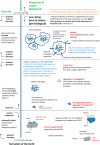Current Ideas about Prebiological Compartmentalization
- PMID: 25867709
- PMCID: PMC4500137
- DOI: 10.3390/life5021239
Current Ideas about Prebiological Compartmentalization
Abstract
Contemporary biological cells are highly sophisticated dynamic compartment systems which separate an internal volume from the external medium through a boundary, which controls, in complex ways, the exchange of matter and energy between the cell's interior and the environment. Since such compartmentalization is a fundamental principle of all forms of life, scenarios have been elaborated about the emergence of prebiological compartments on early Earth, in particular about their likely structural characteristics and dynamic features. Chemical systems that consist of potentially prebiological compartments and chemical reaction networks have been designed to model pre-cellular systems. These systems are often referred to as "protocells". Past and current protocell model systems are presented and compared. Since the prebiotic formation of cell-like compartments is directly linked to the prebiotic availability of compartment building blocks, a few aspects on the likely chemical inventory on the early Earth are also summarized.
Figures


References
-
- Lazcano A. Encyclopedia of Astrobiology. Springer; Berlin/Heidelberg, Germany: 2011. Origin of Life; pp. 1183–1190.
-
- Alberts B., Johnson A., Lewis J., Morgan D., Raff M., Roberts K., Walter P. Molecular Biology of the Cell. 6th ed. Garland Science; New York, NY, USA: 2015.
Publication types
LinkOut - more resources
Full Text Sources
Other Literature Sources
Miscellaneous

